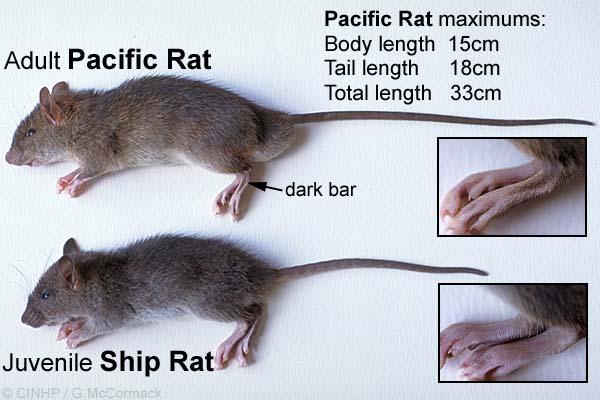Polynesian Rat
Rattus exulansSummary 4
UNDER CONSTRUCTION let me know if you find good illustrations for this page.
The Polynesian rat, or Pacific rat (Rattus exulans), known to the Māori as kiore, is the third most widespread species of rat in the world behind the brown rat and black rat. The Polynesian rat originated in Southeast Asia, and like its relatives, has become widespread, migrating to most Polynesian islands, including New Zealand, Easter Island, and Hawaii. It shares high adaptability with other rat species extending to many environments, from grasslands to forest.
Identification 5
Weight
Typically 60g - 80g (up to 180g)
Length, head-plus-body
180mm (max)
Tail
Slightly shorter or longer than head-plus-body length.
Thin and uniformly dark all over.
Ears
15.5mm - 20.5mm.
Fine hairs do not extend beyond edge of ear.
Hind-foot, length
24.5mm - 31.0mm (adult)
Hind-foot, colour
Outer edge dark near ankle.
Rest of foot and toes pale
Fur, colour on back
Brown.
Fur, colour on belly
White-tipped grey giving irregular colour.
Habits
- Agile climber
- Digs small holes
- Nests mainly on the ground
- Feeds both on the ground and in trees
- Infrequent swimmer
Identification features based on https://www.stat.auckland.ac.nz/~smiller/rat_id
Comparisions 5
Photo from McCormack, Gerald (2007) Cook Islands Biodiversity Database, Version 2007.2. Cook Islands Natural Heritage Trust, Rarotonga. Online at http://cookislands.bishopmuseum.org.
Juvenile rats 5
All the above applies to adult rats, we really need a section dealing with the differences seen in juvenile rats. This is just a placeholder for that section!
Notes about identifying dead rats 5
Identification features such as head shape, ears, and eyes can be affected by being squashed in a trap, eg "large" eyes may simply be the result of the eyes bulging out as a result of head trauma.
Wet fur usually looks dark, so a wet Brown rat may well look black.
And remember "it is not necessarily a straight-forward task identifying what you have caught. The information provided can be fairly variable/vague and should be taken with a grain of salt. Every source says that an identification should be made based on the weight of identifying features, as it is rare to find a specimen matching every feature perfectly. " (🔗rat_id)
Sources and Credits
- (c) Cclborneo, all rights reserved, uploaded by Cclborneo, https://inaturalist.nz/observations/95931879
- (c) Cliff, some rights reserved (CC BY), http://commons.wikimedia.org/wiki/File:Pacific_rat.jpg
- (c) Kittipongchaisiri, all rights reserved, uploaded by Kittipongchaisiri, https://inaturalist.nz/observations/32455528
- Adapted by Tony Wills from a work by (c) Wikipedia, some rights reserved (CC BY-SA), https://en.wikipedia.org/wiki/Rattus_exulans
- (c) Tony Wills, some rights reserved (CC BY-SA)
More Info
- iNat taxon page
- Animal Diversity Web
- ASM Mammal Diversity Database
- Atlas of Living Australia
- Biodiversity Heritage Library
- BOLD Systems BIN search
- Global Biodiversity Information Facility (GBIF)
- iNaturalist Mammal Working Group
- NatureServe Explorer 2.0
- Rat identification in New Zealand
- VertNet
- 日本のレッドデータ検索システム











